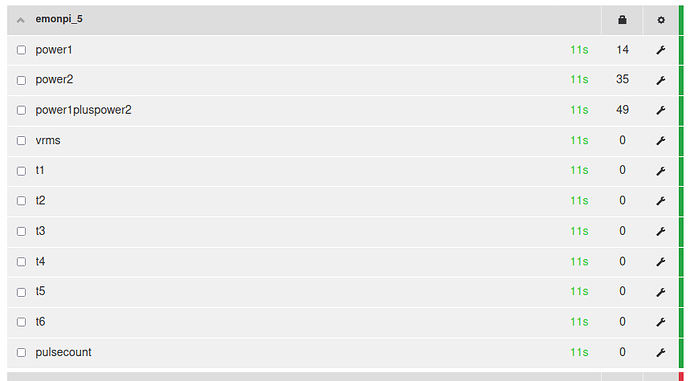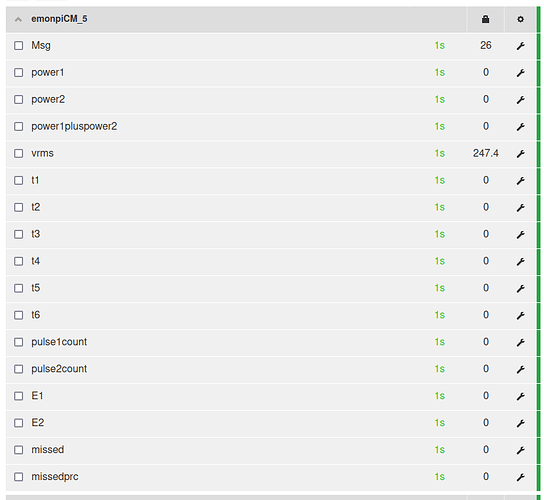Briefly, The emonPi has two main parts -
-
The emonPi Board. This has an ATMega328 microcontroller chip on it, which makes the measurements using the CT1, CT2, 9V AC Sample, and the RJ45 I/O inputs. It also manages the RFM69 radio. The ATMega328 is where the firmware update is applied.
-
the Raspberry Pi, which runs the software. The emonPi Board is plugged into the Pi. The Pi receives the measurements from the ATMega328, stores and processes them and generates the Apps, such as “MySolar”.
The V1.1.4 firmware update to the ATMega328 gives the Continuous Monitoring (CM) version, and updates the radio format to LPL. It also changes the communication speed and content between the emonPi Board and the Pi. This is necessary to include the extra data from the CM version (Msg, pulse2count, E1, E2). The serial rate between the emonPi Board and the Pi has also increased from 38400 to 115200 baud.
The result is that the Pi cannot understand the V1.1.4 data, and the apps etc get no data.
To fix this, the settings in emonHub on the Pi must be edited - for more information see
https://docs.openenergymonitor.org/emonhub/index.html
and in particular
https://docs.openenergymonitor.org/emonhub/configuration.html#editing-the-emonhub-configuration-file
To correct the serial baud rate change, the emonPi [Interfacers] Configuration entry needs to be updated to:
[[emonpi]]
Type = EmonHubOEMInterfacer
[[[init_settings]]]
com_port = /dev/ttyAMA0
com_baud = 115200
[[[runtimesettings]]]
pubchannels = ToEmonCMS,
subchannels = ToRFM12,
group = 210
frequency = 433
baseid = 5 # emonPi / emonBase nodeID
calibration = 230V # (UK/EU: 230V, US: 110V)
quiet = true # Disable quite mode (default enabled) to enable RF packet debugging, show packets which fail crc
# interval = 300
To correct the different message content, the emonPi [Nodes] Configuration entry needs to be updated to:
[[5]]
nodename = emonpi
[[[rx]]]
names = Msg, power1,power2,power1pluspower2,vrms,t1,t2,t3,t4,t5,t6,pulse1count,pulse2count,E1,E2
datacodes = L, h, h, h, h, h, h, h, h, h, h, L, L, l, l
scales = 1, 1,1,1, 0.01, 0.01,0.01,0.01,0.01,0.01,0.01, 1, 1, 1,1
units = n,W,W,W,V,C,C,C,C,C,C,p,p,Wh,Wh
if you are new to editing the settings in emonHub, you can copy the original settings and then paste the copy underneath the original settings . The original settings can then be commented out by adding a hash symbol # at the start of each line. Then the copy can be edited to update it (or you could use the entries above instead of an edited copy of the original - I think they are correct!). If something goes wrong you still have a copy of the original that you can un-comment.
For example, the commented out original for the emonPi [Nodes] Configuration entry would look something like (note the firmware and hardware lines are optional, so may not be present):
#[[5]]
# nodename = emonPi
# firmware = emonPi_RFM69CW_RF12Demo_DiscreteSampling.ino
# hardware = emonpi
# [[[rx]]]
# names = power1,power2,power1_plus_power2,Vrms,T1,T2,T3,T4,T5,T6,pulseCount
# datacodes = h, h, h, h, h, h, h, h, h, h, L
# scales = 1,1,1,0.01,0.1,0.1,0.1,0.1,0.1,0.1,1
# units = W,W,W,V,C,C,C,C,C,C,p
After doing the firmware update and the emonHub changes, it should all start workiing again - fingers crossed!
I don’t know anything about the future of the discrete sampling branch.
Hope this helps …
P.S. You may find that the emonPi LCD display puts the measurements in the wrong place after the upgrade, as I did …

